The Short Version
- The $47 million redevelopment of Bozeman, Montana’s Gallatin Valley Mall — soon to be Gallatin Crossing — has transformed the property into a mixed-use retail destination with a Whole Foods, a surgery center and a walkable high street.
- Bozeman’s rise in popularity, fueled in part by the hit TV show “Yellowstone” and an influx of pandemic-era relocators, helped drive tenant demand for the site.
- Gallatin Mall Group recruited Whole Foods to open its first Montana location, which catalyzed broader redevelopment efforts and attracted aspirational lifestyle brands.
- Medical tenants like Ortho Montana and Intermountain Health added daily-needs appeal while reactivating former anchor space with the new Gallatin Valley Surgery Center.
- The redesign includes new open-air retail, a pedestrian plaza and dual-entrance storefronts to blend enclosed mall and high street formats.
- Owning the land outright allowed Gallatin Mall Group to execute its plan without department store buyouts, giving it a competitive edge in tenant negotiations.

In the decade following the Great Recession, Gallatin Valley Mall in Bozeman, Montana, faced the same struggles as malls across the country in markets big and small. But when owner Gallatin Mall Group began to make changes about six years ago, it drew a pair of pocket aces that mall owners in other communities lacked. Taylor Sheridan’s blockbuster “Yellowstone” TV series, which starred Kevin Costner as Montana Gov. John Dutton III and first aired in 2018, featured Bozeman prominently. Meanwhile, Bozeman and other Montana towns also became pandemic-retreat destinations for urbanites, including many retail CEOs who had second homes in the state.
Those attributes have helped propel a $47 million rehab of the 45-year-old Gallatin Valley Mall, about 2.5 miles west of downtown Bozeman. Over the past five years, Gallatin Mall Group has added a Whole Foods Market, a medical pavilion and a host of lifestyle brands to the property, which has grown from 315,000 square feet to 385,000 and is being renamed Gallatin Crossing. The tenant roster also includes existing tenants Barnes & Noble, Macy’s, an 11-screen Regal movie theater and local retailers and restaurants.
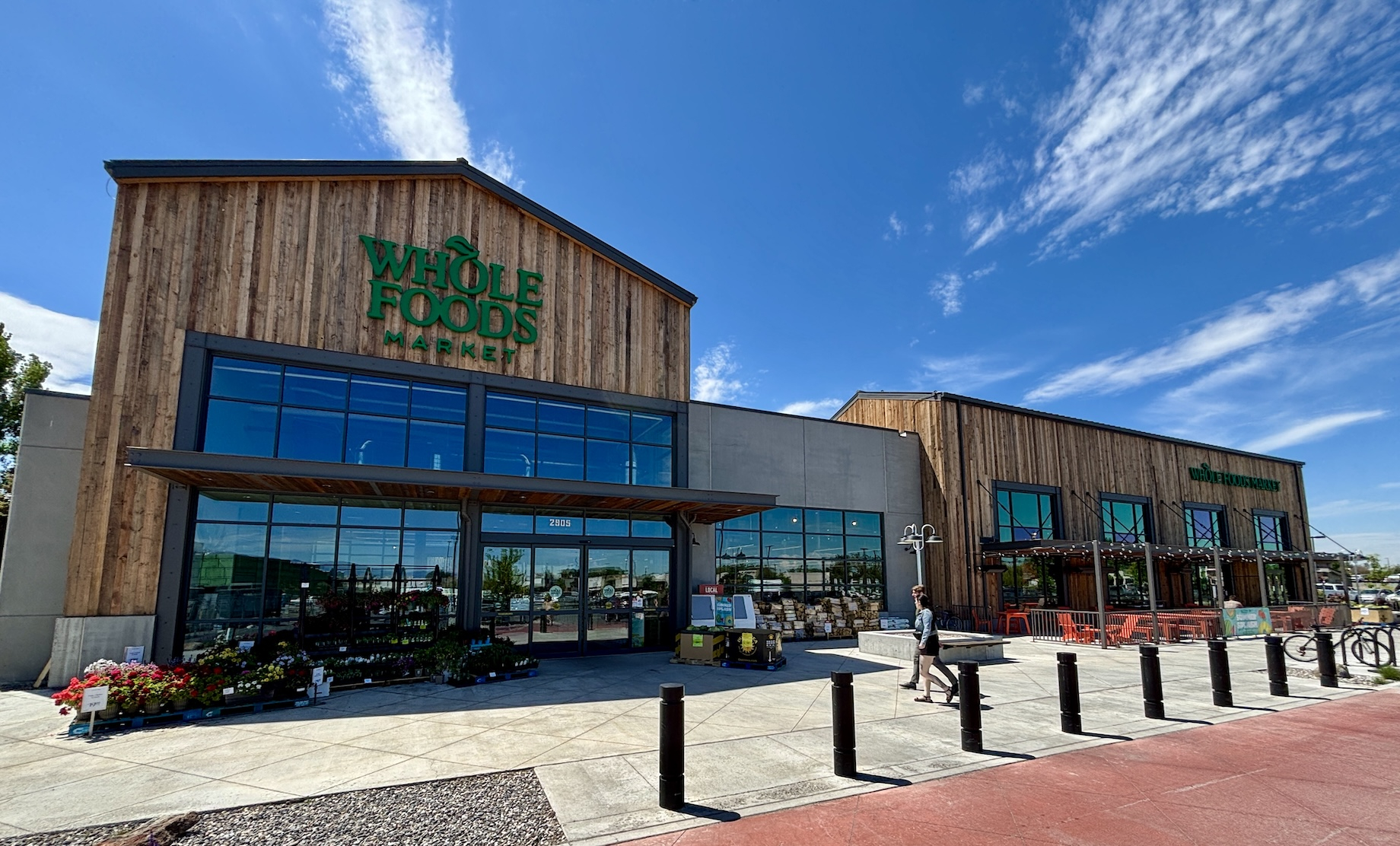
The 2022 addition of a Whole Foods Market has helped catalyze Gallatin Valley Mall’s redevelopment. Image courtesy of Logan Burt
Bozeman’s Boom Brings Big Retail Opportunity
“There was a lot of negative press about malls a few years ago, but it was quite the inverse in Bozeman,” said Corning Cos. vice president Lilly Corning, who is coordinating and overseeing the redevelopment on behalf of Gallatin Mall Group. “Bozeman was enjoying such a meteoric rise that we were in a very unique situation. We had a significant piece of real estate in a high-opportunity market and were in the financial position to be able to invest a significant amount of capital in the redevelopment.”
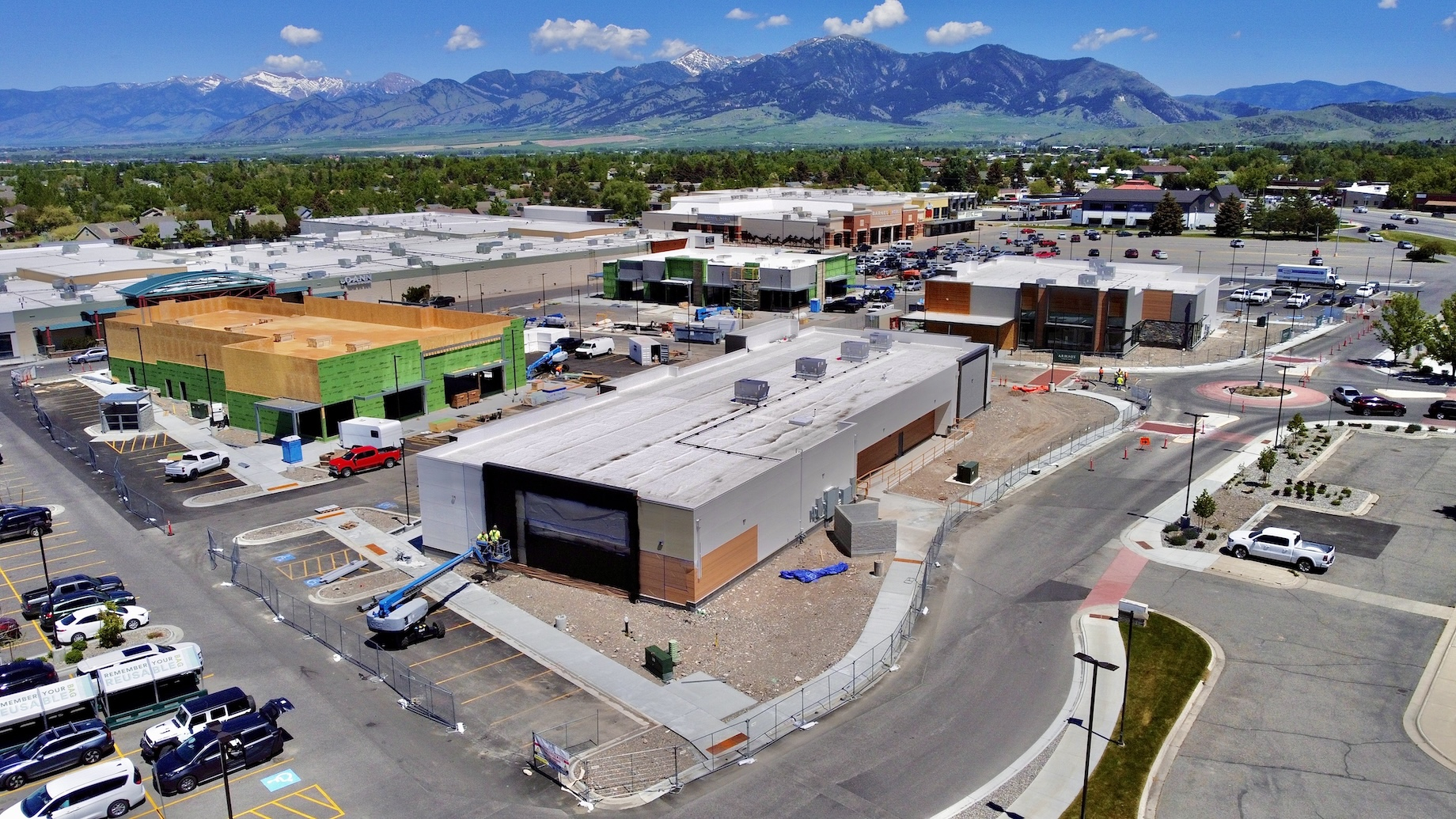
Looking northeast: Gallatin Crossing will include a high street concept that better utilizes a vast parking field. Barnes & Noble and Regal cinemas appear in the background. Photo courtesy of IMEG
First Whole Foods in Montana
Gallatin Mall Group partners Steve Corning and John Morrow purchased the property in 1997 from the estate of Harry Daum, a developer of cookier-cutter malls in small markets across the West and Midwest, said Steve Corning, who is also president of Corning Cos. They soon changed the name from Main Mall to Gallatin Valley Mall and spearheaded a renovation that brought in Barnes & Noble and Regal cinemas to replace a Smith’s Food King grocery store that would be relocating within town. “For 15 years or so, the property clicked on very successfully,” Steve Corning said, “but then, as traditional anchors began to falter as they were doing everywhere, we saw that it was time for a change.”
By 2019, Gallatin Mall Group was exploring a revamp seriously and took to heart what its founders were hearing at ICSC events and reading in its publications and elsewhere: advice to recruit daily-needs tenants to improve traffic, Morrow recalled. Working with a handful of Boston-based development and leasing consultants, including Jeremy Grossman of the Grossman Development Group, Gallatin Mall Group signed Whole Foods in summer 2020 to the grocer’s first Montana location. Whole Foods opened two years later in a new, 30,000-square foot building on an outparcel previously occupied by Fuddruckers.
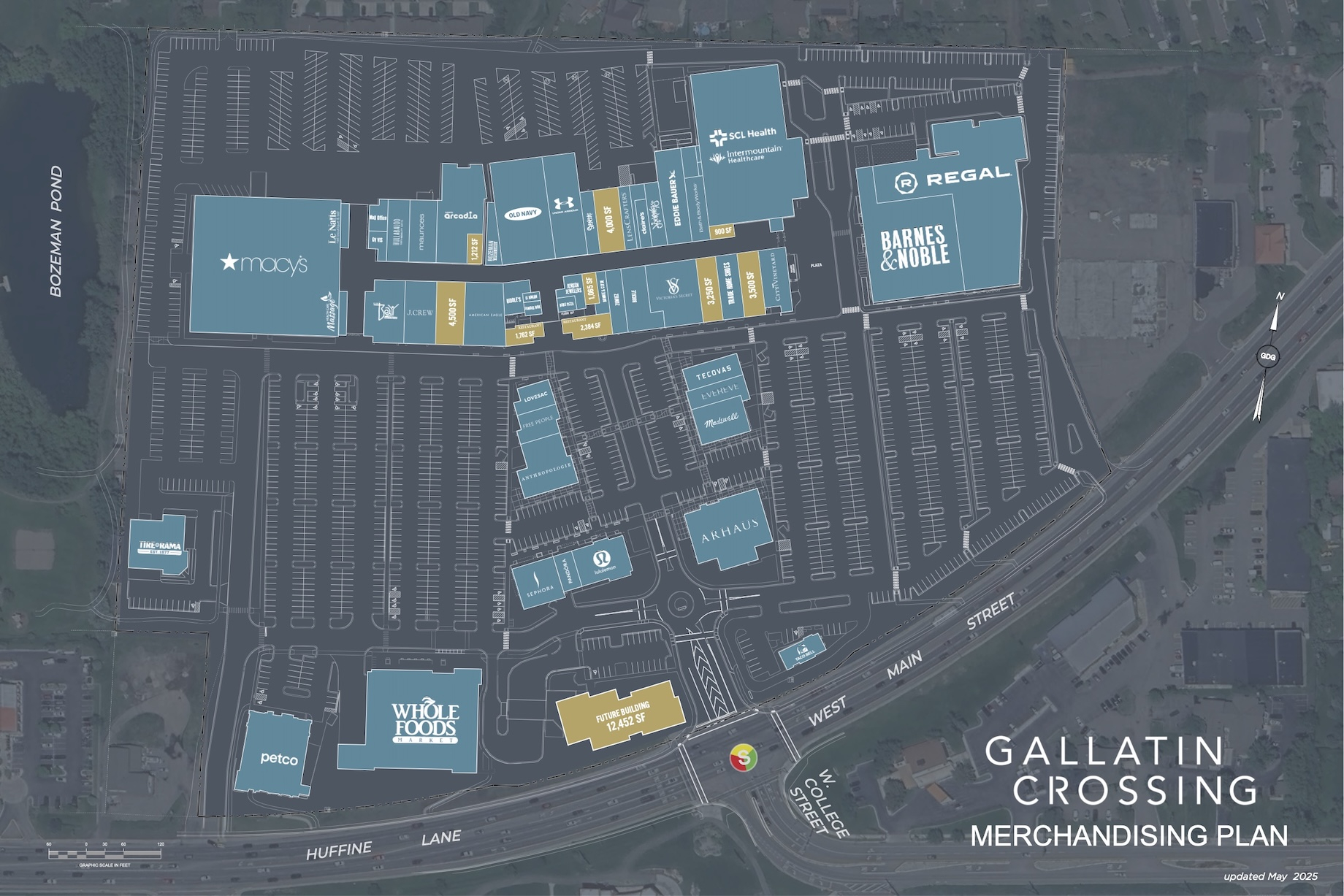
The plan for Gallatin Crossing’s 38 acres. Image courtesy of Grossman Development Group
Initially, the development team anticipated that the Whole Foods and alterations to outparcels would be the extent of the rehab, but Bozeman’s celebrity flourished during the pandemic and Whole Foods’ gravitational pull additionally catalyzed a bigger transformation. In fact, one Yellowstone episode included a quip that the new Whole Foods was a sure sign the town was gentrifying, Morrow said. “When you look at how to activate a mall for daily needs, if you get a Whole Foods or Trader Joe’s or Sprouts, it’s almost textbook,” he noted. “It’s amazing how many aspirational and lifestyle brands want to be next to Whole Foods.”
“When you look at how to activate a mall for daily needs, if you get a Whole Foods or Trader Joe’s or Sprouts, it’s almost textbook.”
Medical Tenants Anchor a Shift Toward Daily-Needs Retail
Key to leveraging that demand was the enlistment of Ortho Montana and Intermountain Health, formerly known as SCL Health, both of which were working with Corning Cos. to enter the Bozeman market. In 2023, the two medical providers agreed to establish the Gallatin Valley Surgery Center in a 45,000-square-foot Medical Pavilion in the former JCPenney location at the back of the property. That project opened last year.
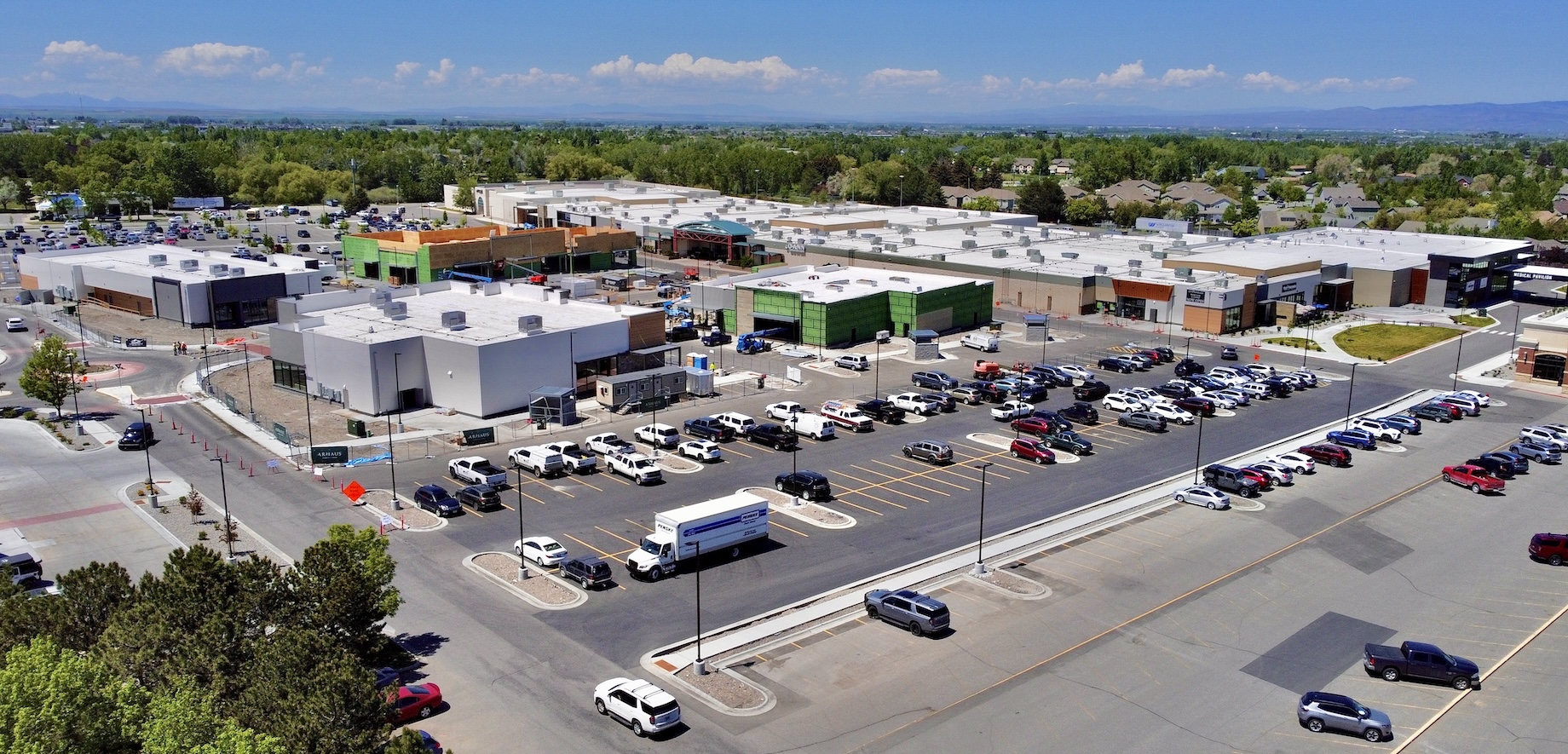
Looking northwest: The completed Medical Pavilion on the northeast end of Gallatin Valley Mall is pictured at right as the property’s high street concept takes shape in the foreground, running between four outparcels perpendicular to the mall. Photo courtesy of IMEG
To improve consumers’ access to the medical providers, the developers removed 26,000 square feet toward the northeast side of the mall, separating the Barnes & Noble/Regal building from the rest of the original structure. That open space became a pedestrian plaza and two new traffic lanes that pass between the Medical Pavilion and Barnes & Noble.
From Parking Lot to High Street: Creating a Lifestyle Destination
That removed 26,000 square feet of gross leasable area there, but Gallatin Mall Group now is almost done building 48,000 square feet across four buildings in the vast parking lot south of the mall. The open-air, walkable high street attracted first-to-Montana lifestyle brands like Arhaus, Anthropologie, Lovesac and Sephora. “Bringing in the medical users was a real game changer,” Morrow explained. “It guided the development, and we have had an oversubscription for the high street project.”
Reactivating the Core With Streetscape Design
Tenant demand for a high street setting also fueled the decision to activate the enclosed mall and strengthen its connection to the rest of the project. The developer is building a streetscape along the front of the mall and exterior entrances to all stores that face the high street and parking lot, Morrow said. The Gallatin Mall Group also wants to retain the stores’ interior entrances. For retailers that don’t want two entrances, the developer is keeping up the energy along the exterior streetscape with large display windows and signage.
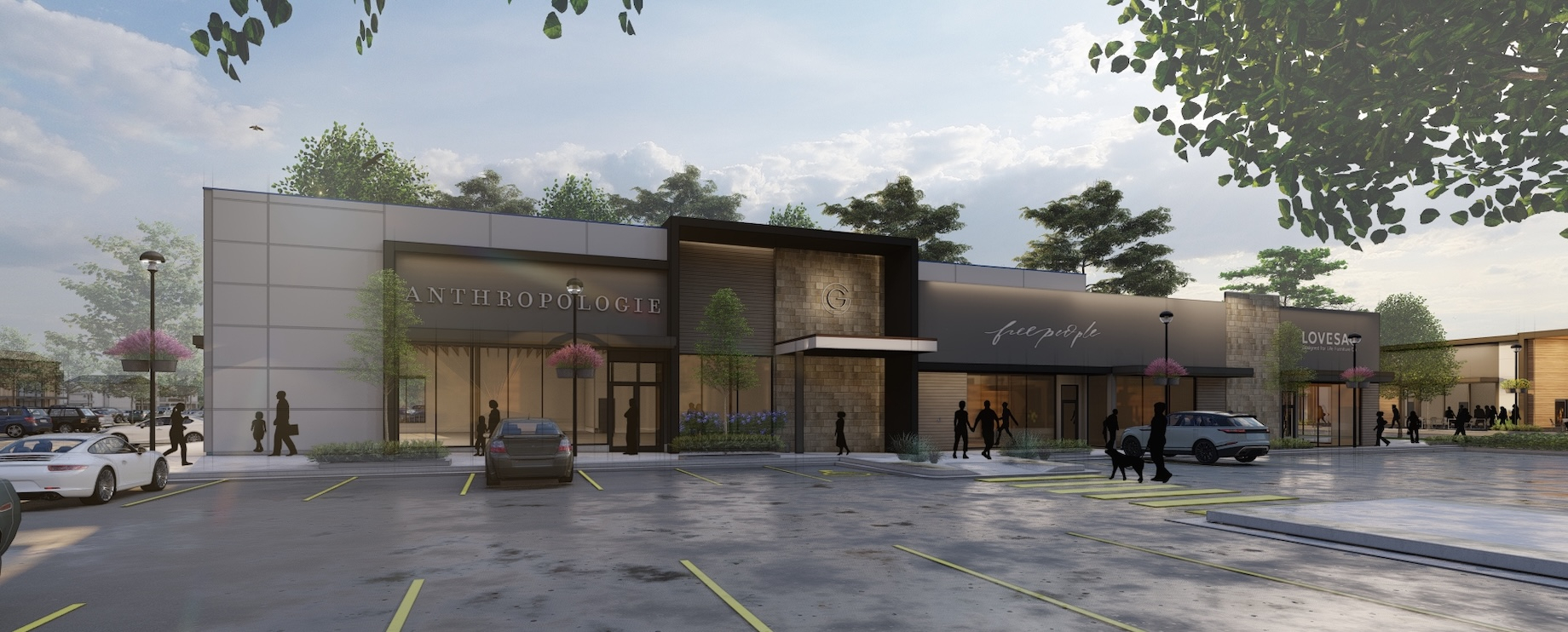
Gallatin Crossing’s high street addition is home to first-to-Montana retailers like Arhaus, Anthropologie, Free People and Lovesac. Rendering courtesy of Collaborative Design
Why Owning the Land Gave Gallatin Mall Group the Upper Hand
Throughout the redevelopment process, the developer has made the most of the property’s inherent advantages. The 38-acre parcel is largely underdeveloped relative to its size, for example, which has allowed the developer to increase the leasable space while reducing the number of parking spaces from seven per 1,000 square feet of leasable area closer to four per 1,000 square feet of leasable area, Corning and Morrow said.
Gallatin Mall Group didn’t have to buy out department stores from the site, either, as it owns all the land. “That has made our deals quite competitive,” Morrow said. “There was probably no way that anybody could have come into this market and outflanked us [for tenants], so we more or less had the upper hand.”
That’s the kind of calculation that would make John Dutton proud.
By Joe Gose
Contributor, Commerce + Communities Today